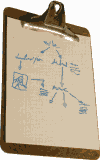|
Whatever you are doing, the first step is to plan. Planning is integral to the success of any project and none more so than web design. Web design is about communicating information graphically. For this to be effective, a great deal of thought must go into what audience your site is being designed for, their needs, wants and aspirations. This is further complicated in web design because of the added levels of interactivity possible through the medium. The key to success in a new media project is to understand the audience. For businesses these are stake holders in the enterprise and include customers, suppliers and all others that affect or are affected by the business.
The first step in web design planning is therefore to research the audience.
Will the current web site do, or does it need redesigning? What is lacking that needs attention. Before money is spent on a site, a business case must be established. Use some log analyser software to check your current site. When users are rarely going beyond the first page it is often due to two reasons, either they are repeat visitors who find nothing new or they simply find nothing to fulfil their needs. A site should be regularly updated and this should be taken into account at the planning stage.
Plan an update every 4 to 8 weeks to make sure that you maintain contact with users.
Your site must contain a message. These will be different for each type of audience, consider your unique selling point and your customers buying influences and combine these to create a powerful message.
Simplicity is the key for the web site infrastructure. It will ensure a fault free site and the largest target audience. A limited number of well thought-out links will allow the user to quickly obtain the information they require. Multi-level menus offer far more links from just one page and many Java or JavaScript based off-the-shelf menus are available for download. The aim is to make the site easily navigable, as nothing annoys users more and it will quickly send them looking elsewhere. A good web design package will include a site tree. This helps you maintain the site and keep all the links active.
Hosting should be carried out by a specialized company with knowledge and experience which they can pass on to you. Find out how to use FTP in advance. Check the site regularly to ensure everything is working. Schedule these checks at times that do not disturb users. Provide a users feedback form to help provide ideas for future updates.
You may be a small company, but you still have your brand and this should be taken very seriously. It is how people perceive the company. Again, think what your company means to your customers and suppliers. This should form the basis of the web sites look. Your branding is the key to your sites design. The approach taken to planning is different for each company, site and individual – follow the methods that suit, take time and care in thinking through exactly what is required from the site and its design and you are guaranteed success.
Remember, keep it short and simple.
|


![]()
